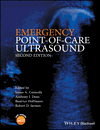Foreign Body and Abscess
Summary
Foreign bodies are often difficult to visualise using plain film radiography. Abscess identification on clinical grounds alone can also be difficult, especially where there is coexisting cellulitis or difficulty in demonstrating fluctuance due to depth. The identification of soft-tissue foreign bodies and abscesses requires an understanding of normal soft-tissue anatomy. As with most ultrasound techniques, the practitioner will better recognise pathology by first having a good understanding of normal anatomy. Foreign bodies frequently occur in the hands and feet, and a good understanding of the relevant anatomy is key to diagnosis and avoiding iatrogenic complications associated with intervention. In the acute phase, foreign bodies often appear echogenic with clean shadowing. Reverberation artefacts may occur and are seen often with smooth or flat surfaces, such as with metal or glass. Reverberation will vary with probe position and beam angle, and will be most apparent when imaging a flat smooth foreign body perpendicular to the ultrasound beam.



